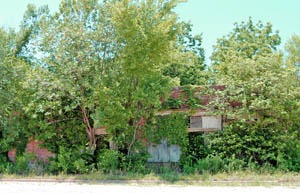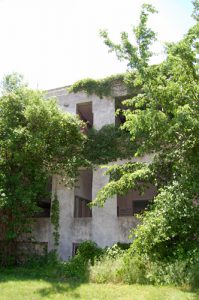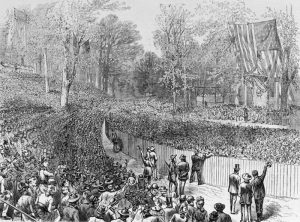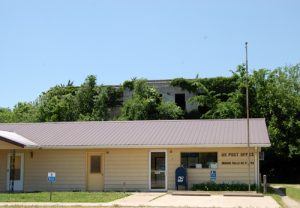Situated along the Neosho River in northeast Woodson County, Kansas, Neosho Falls is the county’s oldest town. A semi-ghost town today, this small town has a population of 134 as of the 2020 census and a total area of 0.57 square miles, of which 0.54 square miles is land and 0.03 square miles is water. It was once the county seat of Woodson County and was described as the most important city in the area.
Its name was taken from the nearby Neosho River, coupled with “Falls,” because one of the first works of early settlers was to build a dam across the rapids, creating the small torrent of water that still exists today. The settlers who would establish the city were Colonel National S. Goss and Isaac W. Dow, who arrived in the area on April 6, 1857, from Iowa. In a one-horse rig, the two skirted the Coffey County line and, just west of where Neosho Falls would be built, found the cabin of Judge John Woolman. The only other person living in the area was John Chapman, who resided on Spring Creek, just north of the Falls.
At that time, Woodson County was the reserve of the New York Indians and not open to official settlement. This, however, did not stop more settlers from coming to the area. In August, another settler named E. Fender built a cabin on the river’s north bank, and the area’s first physician, Dr. A. McCartney, and others came in the Fall. That same year, a post office was established, and National Goss became the postmaster, a position he held for two years.
Ever the entrepreneur, National S. Goss, along with T.L. Clark, B. F. Goss, and William Brown, built a sawmill on the north side of the river in 1857. Soon after it was built, National S. Goss and T.L. Clark became its sole owners, and it was expanded two years later.

Once a prosperous business, this abandoned building can barely be seen behind the trees and vines by Kathy Alexander.
In the Spring of 1858, more settlers arrived, including two men named Ruggles and Stevens. They built a cabin on the south bank of the Neosho River and began selling goods. Later in the year, the two built a frame store and the Falls House Hotel. Before long, J. Fisher erected another store and stocked it with drugs.
Although the land was still part of the New York Indian Reserve, no New York tribes ever occupied it; their only settlement was a temporary one near Fort Scott, Kansas. Finding that the Indians would not settle on the reserve, the Woodson Board of County Supervisors began to organize the county in May 1858. On May 22, the men met at Neosho Falls and issued an order to conduct all county business there. That same month, National S. Goss & Company donated a jail building to the county for as long as Neosho Falls should remain the county seat. In August, the Board of County Supervisors again met at Neosho Falls. It divided the county into Neosho Falls, Liberty, Owl Creek, Belmont, and Verdigris Townships. That same year, the first school was taught on the private property of E.H. Curtis, who afterward served in the Civil War as the Colonel of an African American regiment.
In 1860, the U.S. Government made land available for sale and homesteading in the New York Indian Reserve. News of this movement quickly circulated throughout the county, and the squatter settlers hastened to the land office to make the appropriate entries.
On November 5, 1867, an election was held to locate the county seat permanently. The vote resulted in 129 for Neosho Falls, two for Center, and two for Coloma, giving Neosho Falls a landslide victory. As in many other Kansas counties, however, not everyone was happy with the county seat’s placement. Less than a year later, another election was held on September 21, 1868, which pitted Neosho Falls against Chellis. Neosho Falls won again, but the county seat “fights” would last eight years, ultimately leaving Neosho Falls out in the cold.
The first newspaper in the county was the Frontier Democrat, started in October 1869 by Isaac Boyle. Boyle published the paper at Neosho Falls until January 1870, when it was sold to William H. Slavens, who changed the name to the Neosho Falls Advertiser.
A public schoolhouse was built in 1869, and I. S. Jones, who would later become a Probate Judge of Woodson County, taught the first classes in 1870.

Though several churches once existed in Neosho Falls, the only one left today is the Methodist Church, photo by Kathy Alexander.
The year 1870 was a busy one for Neosho Falls: the town was incorporated, Isaac W. Dow started a bank, and the Union Pacific Railroad pushed through town, establishing a depot and a large storehouse in the southern part of town. It later became the Missouri, Kansas & Texas Railway. That same year, the Falls House, the only hotel in town, was dramatically rebuilt and enlarged, and the city’s first churches were built.
Elections for city officers were held in early 1871. By this time, the school building erected just two years earlier had already proved inadequate, so a $500 addition was made. The following year, another building was added.
In the meantime, the newspaper changed hands and management several times, becoming the Woodson County Post in January 1873. That same year, the sawmill, which had since passed into the hands of Cobert & Cozine, was sold to W.L. Parsons. The Hillings Brothers built another mill, a woolen manufacturer, on the south side of the Neosho River, the same year. Isaac Dow’s bank failed that year, leaving the town without one for several years.
Later, in 1873, yet another county seat election was held on November 3, in which the county seat was moved to Kalida, a town located about two miles southeast of Yates Center. Just a few months later, on February 23, 1874, Kalida would lose its short-lived status as a county seat to Defiance. Yet another election was held the following year between Defiance, Neosho Falls, and Yates Center. The tally between Neosho Falls and Yates Center was so close that a second election was held to make the final decision. The hotly contested race culminated in a September 12, 1876, vote, with Yates Center receiving 488 votes and Neosho Falls 426. The county seat question was never again revived.
In 1876, the American Hotel, built some years earlier, was closed because it was too far from the business center. It was moved near the railroad tracks and converted into a freight warehouse. Another hotel, the Pierce House, also burned that year and was never rebuilt.
The largest enterprise was the Neosho Valley Fair, held here in 1875. Four counties—Allen, Anderson, Greenwood, and Woodson—participated, influencing the area’s development. The fair gained a reputation far and wide, and in 1879, guests included President Rutherford B. Hayes, his wife, General William T. Sherman, and several state officers.
Neosho Falls reached its peak population of 1,200, but over the next several decades, it continued to decline.
In 1881, the grist mill was rebuilt with a substantial 30×36 two-story building. This mill had a daily capacity of 100 barrels of flour. The following year, the woolen mill was sold and never reopened. However, 1882 also brought a new bank to town, started in August by Haughwout & Goodrich.
In 1885, Neosho Falls had Methodist, Christian, Presbyterian, and Congregational Churches and two good public-graded schools, three hotels, woolen, saw and flour mills, a weekly newspaper called the Neosho Falls Post, four hardware dealers, three blacksmiths, six general stores, a grocery store, a barber, a milliner, a shoemaker, a lumber dealer, a bank, two stone quarries, two druggists, three doctors, two restaurants, a justice of the peace, two furniture dealer, an undertaker, stagecoach services, wagon makers, brick makers, an attorney, a tailor, a dressmaker and several carpenters, cider makers, teachers, carpet weavers, butter and cheese makers, livestock dealers, fruit growers, livestock men, insurance agents, and a population of 900. The assessed valuation of real and personal property was $98,000. Wool, grain, flour, livestock, and lumber were shipped. Stagecoaches ran daily to Colony, 12 miles northeast, and to Yates Centre, 16 miles southwest, and tri-weekly to Williamsburgh.
By the turn of the century, Neosho Falls was described as one of the important towns of Woodson County. It was a significant transportation center located at the junction of the Atchison, Topeka & Santa Fe, and the Missouri, Kansas & Texas railroads, and on the Neosho River. At that time, the town boasted several retail businesses, a couple of banks, and manufacturing facilities, including flour, saw, and sorghum mills. The Woodson County Post newspaper was still in circulation. By this time, oil had also been discovered in the vicinity, bringing much prosperity. In 1910, the town had a population of 571.
However, in the first half of the 20th century, Neosho Falls began to experience one setback after another. As electricity replaced water power, many mills were closed, and although a hydroelectric plant was built, its tenure was short and it was soon abandoned. The city was struck by a disastrous flood in 1926, which caused one death and tens of thousands of dollars in damage. Like so many others, the Great Depression hit the town hard, and Neosho Falls lost its only newspaper and its only bank in the 1930s. In 1935, the Santa Fe Railroad pulled out of the town, though it was still left with the Missouri, Kansas & Texas Railway line and depot.
Prosperity returned to Neosho Falls when new oil was struck south of town in 1937. Two years later, anticipating a return to prosperity, a large, combined elementary and high school was built. But, for Neosho Falls, re-growth wouldn’t last. A devastating flood destroyed much of the town in 1951.

The old school continues to stand as a testament to concrete, though the sounds of children’s voices have been gone for decades, Kathy Alexander.
In 1957, the Missouri, Kansas & Texas Railway pulled out of the area, and the population continued to fall. The high school closed in 1961, and the grade school in 1969.
Though long past its peak activity, it operates a post office, a church, a Senior Center, a community building, and one retail business – a tavern and several oil businesses with leases that continue to produce. One resident tells us, “Neosho Falls may not be the ‘boom town’ that it once was, but we like it just the way it is.”
Neosho Falls is located about 20 miles northeast of Yates Center. From there, go east to Piqua on Kansas Highway 54, turn north on Xylan Road for about four miles, left on 180th Road for one mile, and right on Willow Road for 1.3 miles to Neosho Falls.
©Kathy Alexander/Legends of Kansas, updated December 2026.
Also See:
Sources:
1884-1885 State Gazetteer and Business Directory, R. L. Polk & Co., Chicago, IL.
Blackmar, Frank W.; Kansas: A Cyclopedia of State History, Vol I; Standard Publishing Company, Chicago, IL 1912.
Cutler, William G.; History of Kansas; A. T. Andreas, Chicago, IL, 1883.
Only in Kansas
Wikipedia





